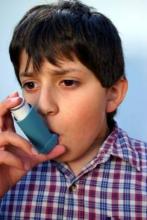SAN DIEGO – Asthma and airway hyperresponsiveness may be underrecognized in children with eosinophilic esophagitis, results from a controlled cross-sectional study demonstrated.
While previous studies have estimated the prevalence of asthma in children with eosinophilic esophagitis (EoE), to range from 24-42%, a recent analysis presented during a late-breaker abstract session at annual meeting of the American Academy of Allergy, Asthma, and Immunology found that up to 70% of children with EoE may suffer from asthma.
"Clinicians treating children with eosinophilic esophagitis should consider asking additional history questions related to asthma symptoms and may also want to consider pulmonary function testing or referral to an asthma specialist for evaluation," lead author Dr. Nadia L. Krupp said in an interview prior to the meeting. "This is the first study to formally evaluate lung function and airway hyperresponsiveness in children with EoE. Prior estimations of asthma have solely come from patient/parent report."
Dr. Krupp, director of the Riley Asthma Care Center in the section of pulmonology, allergy, and critical care medicine at Riley Hospital Children, Indianapolis, and her associates conducted a cross-sectional study of 33 children aged 6-18 years with EoE and 37 healthy controls. The researchers performed methacholine challenge (airway hyperresponsiveness defined as provocative concentration of methacholine less than 8mg/mL), and exhaled nitric oxide. They also analyzed peripheral blood for total IgE, eosinophil count, eotaxin, and serum cytokines.
Baseline spirometry did not significantly differ between EoE subjects and healthy controls. However, airway hyperresponsiveness was present in 33% of children with EoE, compared with only 10.8% of healthy controls (P = .04). In addition, 20% of the 15 EoE subjects with asthma had airway hyperresponsiveness, compared with 44% of the 18 EoE subjects without asthma. Overall, 69.7% of EoE subjects had either asthma or airway hyperresponsiveness.
The researchers found that airway hyperresponsiveness correlated strongly with serum IgE (P less than .0001) and exhaled nitric oxide (P = .0002), while epidermal growth factor (EGF) and fibroblastic growth factor–2 (FGF-2) were elevated in subjects with EoE and asthma, compared to healthy controls and those with EoE but no asthma (P less than .05). In addition, subjects with EoE and asthma who were on asthma controller medications had similar levels of EGF and FGF-2 as healthy controls, while Th2 cytokines and eotaxin did not differ significantly among any groups.
Dr. Krupp said she was surprised "by the fact that airway hyperresponsiveness was more prevalent in those subjects without a history of asthma than those with a known diagnosis, and the fact that Th2-related cytokines were not significantly different between healthy controls and EoE subjects."
She acknowledged certain limitations of the study, including its cross-sectional design and "the fact EoE subjects may have had significant variability in the current activity of their esophageal disease at the time of enrollment."
The study was partially funded by Aerocrine. Dr. Krupp said that she had no relevant financial conflicts to disclose.



